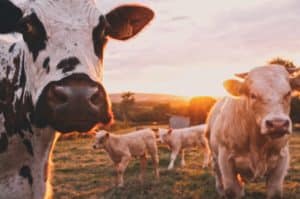Austria is among the leading countries in Europe when it comes to the consumption of meat and meat products – which is neither beneficial for the environment nor for our health. Switching to a more environmentally friendly diet AND still enjoying your food is really easier than you might think.
On average, Austrians eat 63kg of meat every year. This is three times the volume recommended by the Ministry of Health. Excessive consumption can cause overweight, cardiovascular problems, high cholesterol, or diabetes.
Deforestation in the rain forest
The global hunger for meat has its impact on the environment. Greenhouse gases are emitted all along the value production chain, which pours fuel on the climate crisis. The use of resources is massive, especially for the production of animal feed.
Vast surface areas of rain forest are destroyed every year in countries like Brazil and Argentina to facilitate the cultivation of soy. This furthers species extinction and cuts into the reservoirs of carbon dioxide and providers of oxygen.
“The fact that we are destroying our livelihood for the sake of the mass production of meat – which is unhealthy for us anyway – is a disaster,” says Helene Glatter-Götz, food expert with WWF Austria. “And what’s more, the farm animals in this mass production that eat the feed are also treated inhumanely from birth.”
Less and better
WWF Austria recommends: if you do not want to drop meat and sausage from your diet, you should eat less, but better meat. Reduced levels of consumption would lead to reduced mass production, a slowdown in the climate crisis, and the conservation of resources. Besides, meat is an expensive item in the diet. Less meat also means savings for the household budget.
A recent WWF study shows that if an average family switches to a healthy diet, i.e. more fruit and vegetables, less meat and soft drinks, it can afford to buy 70% of its food organic.
But what does better meat mean? Quality beats quantity. This mainly means organically produced meat. That is how you can be sure that no animal feed has been used that harms the rainforest or that has been genetically modified. Also, the breeding standards are higher.
WWF meat guide as help
Meat production as such has a large environmental footprint, but it also depends very much on what is produced where and how. Therefore, WWF Austria has published a meat guide that rates the environmental effects of various production methods by farm animal. It compares organic and conventional production in Austria, Germany, and other EU countries and points out plant-based alternatives alongside beef, pork, and chicken.
The guide describes the various effects on climate and biodiversity, the amount of nutrient input into soil and water, the administration of antibiotics, and the well-being of the animal during breeding. The guide is meant to create transparency for the consumers and help in decision-making. It also targets producers who want to improve certain criteria as well as decisionmakers in retail, who want to adjust their inventory.
Alternatives to schnitzel et al.
The good news: there is an almost inexhaustible number of ways to cut meat from the diet and still ensure a sufficient caloric intake. And they are tasty to boot: vegetables like aubergines, peppers; legumes such as beans, peas, lentils, or chickpeas; mushrooms, tofu, and seitan. Chickpeas have a particularly high protein content. There is a vast array of different recipes for you to sample!
Exquisite BBQs
Especially now during BBQ season, meat tops the shopping list. But there are alternatives. Have you ever tried halloumi or vegetable skewers? Stuffed courgettes, seitan or plant-based sausages – there are no limits. Supermarkets have really stepped up their game in this department.
Legal note:
Prognoses are no reliable indicator for future performance.
Legal disclaimer
This document is an advertisement. Unless indicated otherwise, source: Erste Asset Management GmbH. The language of communication of the sales offices is German and the languages of communication of the Management Company also include English.
The prospectus for UCITS funds (including any amendments) is prepared and published in accordance with the provisions of the InvFG 2011 as amended. Information for Investors pursuant to § 21 AIFMG is prepared for the alternative investment funds (AIF) administered by Erste Asset Management GmbH pursuant to the provisions of the AIFMG in conjunction with the InvFG 2011.
The currently valid versions of the prospectus, the Information for Investors pursuant to § 21 AIFMG, and the key information document can be found on the website www.erste-am.com under “Mandatory publications” and can be obtained free of charge by interested investors at the offices of the Management Company and at the offices of the depositary bank. The exact date of the most recent publication of the prospectus, the languages in which the key information document is available, and any other locations where the documents can be obtained are indicated on the website www.erste-am.com. A summary of the investor rights is available in German and English on the website www.erste-am.com/investor-rights and can also be obtained from the Management Company.
The Management Company can decide to suspend the provisions it has taken for the sale of unit certificates in other countries in accordance with the regulatory requirements.
Note: You are about to purchase a product that may be difficult to understand. We recommend that you read the indicated fund documents before making an investment decision. In addition to the locations listed above, you can obtain these documents free of charge at the offices of the referring Sparkassen bank and the offices of Erste Bank der oesterreichischen Sparkassen AG. You can also access these documents electronically at www.erste-am.com.
N.B.: The performance scenarios listed in the key information document are based on a calculation method that is specified in an EU regulation. The future market development cannot be accurately predicted. The depicted performance scenarios merely present potential earnings, but are based on the earnings in the recent past. The actual earnings may be lower than indicated. Our analyses and conclusions are general in nature and do not take into account the individual characteristics of our investors in terms of earnings, taxation, experience and knowledge, investment objective, financial position, capacity for loss, and risk tolerance.
Please note: Past performance is not a reliable indicator of the future performance of a fund. Investments in securities entail risks in addition to the opportunities presented here. The value of units and their earnings can rise and fall. Changes in exchange rates can also have a positive or negative effect on the value of an investment. For this reason, you may receive less than your originally invested amount when you redeem your units. Persons who are interested in purchasing units in investment funds are advised to read the current fund prospectus(es) and the Information for Investors pursuant to § 21 AIFMG, especially the risk notices they contain, before making an investment decision. If the fund currency is different than the investor’s home currency, changes in the relevant exchange rate can positively or negatively influence the value of the investment and the amount of the costs associated with the fund in the home currency.
We are not permitted to directly or indirectly offer, sell, transfer, or deliver this financial product to natural or legal persons whose place of residence or domicile is located in a country where this is legally prohibited. In this case, we may not provide any product information, either.
Please consult the corresponding information in the fund prospectus and the Information for Investors pursuant to § 21 AIFMG for restrictions on the sale of the fund to American or Russian citizens.
It is expressly noted that this communication does not provide any investment recommendations, but only expresses our current market assessment. Thus, this communication is not a substitute for investment advice, does not take into account the legal regulations aimed at promoting the independence of financial analyses, and is not subject to a prohibition on trading following the distribution of financial analyses.
This document does not represent a sales activity of the Management Company and therefore may not be construed as an offer for the purchase or sale of financial or investment instruments.
Erste Asset Management GmbH is affiliated with the referring Sparkassen banks and Erste Bank.
Please also read the “Information about us and our securities services” published by your bank.
Subject to misprints and errors.



